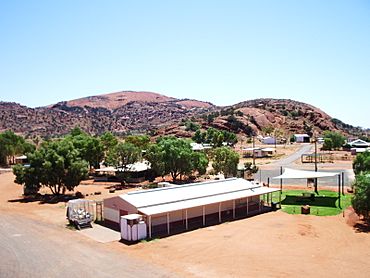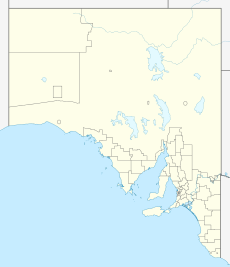Watarru facts for kids
Quick facts for kids Watarru CommunitySouth Australia |
|||||||||
|---|---|---|---|---|---|---|---|---|---|

Watarru Community buildings with wind farm in background courtesy of Appropriate Energy
|
|||||||||
| Population | 56 (2001 census) | ||||||||
| Established | circa 1980s | ||||||||
| Postcode(s) | 0872 | ||||||||
| Location |
|
||||||||
| LGA(s) | Anangu Pitjantjatjara Yankunytjatjara | ||||||||
| State electorate(s) | Giles | ||||||||
| Federal Division(s) | Grey | ||||||||
|
|||||||||
Watarru Community is a special place for Aboriginal people in South Australia. It's located in the Anangu Pitjantjatjara Yankunytjatjara (APY) lands, which are also known as "The Lands." These lands are home to several Aboriginal communities, including Watarru. Watarru Community is nestled at the base of Mount Lindsay, and sometimes people even call it "Mount Lindsay."
Contents
Time in Watarru
The APY Lands, where Watarru is located, have a special time zone. They do not use daylight saving time. This is different from the rest of South Australia.
The time zone used all year is Australian Central Standard Time (UTC+9:30). This is the same time as Darwin, not Adelaide. This helps with connections to the Northern Territory.
Where is Watarru?
Watarru Community is about 550 kilometres southwest of Alice Springs. It sits at the foot of Mount Lindsay. This area is part of the Great Victoria Desert.
Watarru Community is also inside the Watarru Indigenous Protected Area. This special area helps protect the land and its culture. In 2001, it was the largest Indigenous Protected Area. It covers a huge space of 12,800 square kilometres.
Weather in Watarru
The weather in Watarru is similar to the nearby Giles in Western Australia. Summers are very hot. The average high temperature in January is 37.2 degrees Celsius.
Winters are much cooler. The average high in July is 19.9 degrees Celsius. Nights can get quite cool. The average low in June is 6.8 degrees Celsius. Watarru gets about 284.2 millimetres of rain each year.
People of Watarru
In 2001, the population of Watarru Community was 56 people. Most of these residents, about 82.1%, were Indigenous Australians. The community's power station was built to handle a changing number of people. This means it can provide power for 30 to 90 residents. The people living here are mainly Anangu people.
History of the Community
Watarru Community started to grow in the early 1990s. It was founded by a small group of Anangu families. These families had returned from other established communities to live on their traditional lands.
Community Facilities
Watarru Community has several important facilities for its residents.
Local Services
The local store gets fresh food once a week by a large truck called a road train. There is also a workshop for small repairs. Only diesel fuel is available for vehicles. Cars that use petrol need to check if they can use Avgas, which is a special type of fuel.
Mail is delivered once a week by plane from Alice Springs. Other goods are brought in weekly by road train. Watarru now has unleaded fuel for cars. This fuel is special because it cannot be sniffed, which helps keep people safe. Avgas is no longer available.
Community Office and Work
Watarru has a community office. This office handles administration tasks. It also provides internet access for the community. The office is a place where local art projects are organized.
Managing the land provides jobs for the people of Watarru. They help look after native animals. They also manage animal populations like camels and foxes.
Education and Safety
The Watarru Anangu school opened in 1986. It has about 25 students. Watarru does not have a medical clinic that is always open. There is also no permanent police presence. Police officers from Marla patrol the area regularly.
Power and Entertainment
Electricity in Watarru comes from a mix of sources. They use solar power and a wind turbine. This energy is stored in batteries. Two diesel generators also help produce power.
Like most communities in the APY lands, Watarru can watch television. They receive channels from the Australian Broadcasting Corporation and Special Broadcasting Service. They also get Seven Network and Imparja television. Subscription TV, like Austar, is also available.
Visiting Watarru
To visit any community on the APY lands, you need a special permit. These lands are owned by the Aboriginal people. Entering without a permit is against the law. There are serious penalties for doing so.


